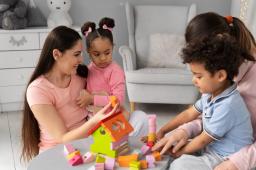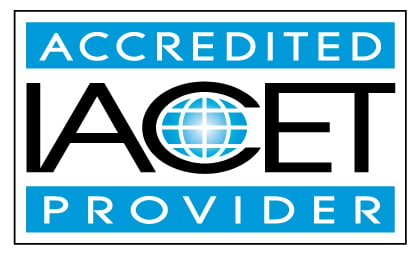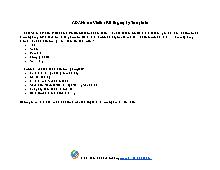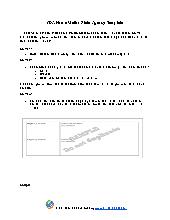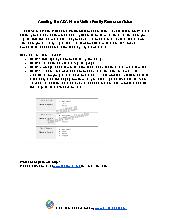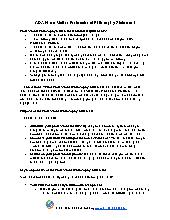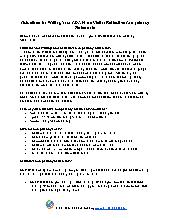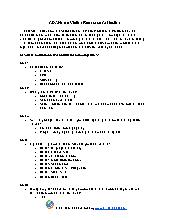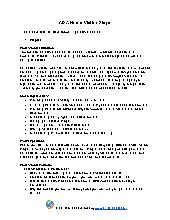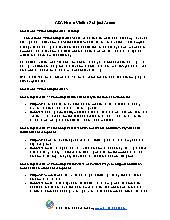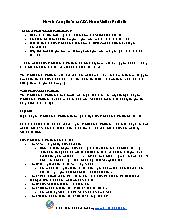CDA Home Visitor Credential Birth to 5
Embark on the path to mastering home visits with our Home Visitor CDA Credential Birth to 5 Training! Prepare to empower families, strengthen connections, and leave a lasting impact on young children, all from the comfort of their homes.
This training is designed to help participants earn their Home Visitor CDA credential, tailored for caseworkers who conduct home visits with families of children from birth to 5 years old.
The Home Visitor CDA Credential is a specialized program for caseworkers involved in home visits with families of young children. This training provides home visitors with the skills needed to engage effectively with parents, manage cases during home visits, and build collaborative partnerships with community agencies to enhance program support.
As adult educators, home visitors play a vital role in empowering parents of young children. They demonstrate expertise in case management during home visits and work closely with various community organizations to improve program outcomes. The training includes 120 hours of formal early childhood education and adult learning principles.
Home visitors acquire the knowledge and skills required to manage cases during home visits, ensuring professional and effective interactions with families. A key focus of the training is developing strong working relationships with community agencies, enabling home visitors to collaborate smoothly with other organizations to strengthen program support.
Subject Area Focus:
The training covers eight key Home Visitor CDA subject areas, with 15 training hours dedicated to each area, ensuring a thorough understanding of all critical aspects related to home visiting.
Be sure to review How to Get the Home Visitor CDA for additional requirements beyond the 120 hours of training.
By the end of this training, the learner will be able to:
- Describe common myths and misconceptions about time management in child care.
- Explain the importance of using contracts and employee training & screening procedures.
- Demonstrate an understanding of the importance of print knowledge.
- Demonstrate an understanding of how genetics and environment influence child growth and development.
- Identify resources addressing health, safety and nutrition topics (CPR, 911, CDC, WIC, Poison Control)
- Identify recommended medical and immunization schedules for children birth through age three
- Demonstrate knowledge of appropriate child abuse reporting process
- Identify strategies for effective communication with families.
- Give examples of ways to apply and model ethical behavior and professional integrity with all children and youth.
- Give examples of ways to apply and model ethical behavior and professional integrity with community members and organizations.
- Give examples of ways to apply and model ethical behavior and professional integrity with families.
- Identify and contemplate bias and explore anti-bias approaches that support working with children and families.
- Give examples of appropriate sensory activities for infants and toddlers.
- Demonstrate an understanding of translating assessment and observational information into short and long term goal development
- Identify strategies to prevent Adverse Childhood Experiences
- Demonstrate an understanding of brain development in young children.
- Demonstrate understanding of brain development in young children.
- Identify staff evaluation tools and evaluation timelines that will assist with staff supervision and monitoring performance
- Explain the possible signs, causes, and results of TBI in early childhood
- Demonstrate the elements of positive respectful relationships that include warm, nurturing interactions with children.
- Identify and demonstrate an understanding of the content requirements for staff orientation.
- Identify coaching prerequisites.
- List the characteristics of effective coaches.
- Distinguish between the personalities of coaches and mentors
- Identify if coaching and mentoring is for you.
- Demonstrate an understanding of the different learning styles of adult learners.
- Identify the components of active listening skills.
- Describe nonverbal communication as it relates to coaching and mentoring.
- Explain intercultural communication as it relates to coaching and mentoring.
- Explain the value of self-evaluation and reflection.
- Define SMART goals and describe its historical context.
- Demonstrate understanding of the importance of professional etiquette while coaching and mentoring.
- List strategies for coaches and mentors on how to apply DEI practices in child care.
- Identify strategies for coaching and mentoring individuals with challenging personalities.
- Demonstrate understanding of how to write effect SMART Goals.
- Describe the importance of providing opportunities for children to practice independence.
- Explain the benefits of setting goals in a coaching/mentoring program.
- Identify and use strategies for effective communication with community and colleagues.
- Demonstrate an understanding of the importance of establishing realistic expectations for behavior.
- Demonstrate the importance of using various strategies to develop language and communication skills.
- Demonstrate an understanding of approaching parents as equal partners in learning.
- Demonstrate an understanding of using community resources for referrals.
- Recognize the importance of maintaining confidentiality and privacy in communication with staff.
- Describe ways child care professionals can support advocacy issues.
- Identify the differences between developmental screening and assessments.
- Recognize the importance of the use of developmental screenings.
- Identify coaching and mentoring strategies.
- Describe the history of early childhood education in the U.S.
- Identify the misconception that classroom curriculum is more important than social relationships.
- Identify strategies for providing appropriate care for infants and toddlers with chronic health issues
- Explain the consequences for children experiencing negative interactions and vocal tones in the classroom.
- Describe the five critical needs for children to develop optimal emotional health
- Demonstrate an understanding of the physical, emotional, and motor development in children five to twelve years of age
- Identify significant events surrounding the evolution of early childhood education in America.
- Identify appropriate activities for children birth through age three
- Demonstrate an understanding of content areas and how they are related to child development.
- Identify the features of effective instruction for print knowledge.
- Give examples of strategies caregivers can teach young children to cope with grief in healthy ways.
- Identify resources that will assist with record keeping.
- Identify practices for managing Illnesses, diseases, allergies, and medication in child care.
- Describe the role of a CDA home visitor and include examples of home visitors.
- Demonstrate an understanding of facilitating resources and activities for families.
- Identify Home Visitor program models and characteristics of effective models.
- Demonstrate an understanding of the Tribal Maternal, Infant, and Early Childhood Home Visiting program.
- Identify the importance of maintaining cultural sensitivity while working with families during home visiting.
- Describe the components of the ASQ.
- Identify ways home visitors work across the child welfare continuum.
- Identify statistics on child and family well-being in relation to home visiting programs.
- Identify the ways Home visitors take on the role of coach or mentor with families.
- Demonstrate understanding of how home visitors can stay safe while visiting homes.
- Describe strategies and experiences to promote collaboration between child and youth care professionals and programs and other professionals involved in the care and education of all children and youth.
- Give examples of ways to show respect for family differences.
- Define Adverse Childhood Experiences and identify its effects on child development
- Define culture and cultural competency
- Recognizing and preventing shaken baby syndrome
- Recognize strategies for effective conferences with families.
- List which professions are mandated reporters.
- List safety risks for infants and toddlers and strategies to diminish these risks.
- List resources and the referral process for preschoolers with a suspected/diagnosed disability.
- Describe infant/toddler nutritional needs.
- Describe the difference between unintentional injuries and nonfatal injuries children can experience.
- Describe the steps teachers should take to identifying challenging behaviors.
- Explain appropriate crib guidelines for caregivers to ensure safe sleep for infants and young toddlers.
- Identify ways to reflect on one's own personal perspectives with courage and/or humility
- Identify ways to interact respectfully and appropriately in a variety of cultural contexts
- Identify ways to examine child behavior to prepare for guidance.
- Identify theorists of guidance and discipline
- Give examples of strategies teachers can use to communicate with parents regarding challenging behaviors.
- Define and identify common signs and behaviors of children and youth with depression.
- Identify Jean Piaget's stages of cognitive development.
- Identify theory and theorist in relation to child development.
- Define and identify common signs and behaviors of children and youth with developmental disabilities.
- Define and identify common signs and behaviors of children and youth with ADHD.
- List community resources, supports, and referrals for ADHD.
- Identify factors that influence learning.
- List community resources, support, and referrals for developmental disabilities.
- Identify similarities between major theories.
- Demonstrate an understanding of prenatal development and its impact on child development.
- Define and identify common signs and behaviors of children and youth with hearing loss.
- Demonstrate understanding of inclusionary practices for autism spectrum disorder in the child care setting.
- Demonstrate an understanding of how the community in which a child lives influences development
- Describe the importance of social emotional skill development in children entering kindergarten.
- Define and identify common signs and behaviors of children and youth with conduct disorder.
- Demonstrate an understanding of how to support all children and youth at times of change, transition, or separation.
- Recognize the impact of unexpected changes on children and youth.
- Illustrate ways to apply the essentials of using supportive social learning to handle behavior issues.
- Demonstrate an understanding of how learning experiences develop emerging skills
- Identify strategies to increase scientific inquiry in the infant and toddler classroom
- Define resilience and identify ways it helps young children overcome toxic stressors.
- List community resources, supports, and referrals for fetal alcohol syndrome.
- Give examples of ways to collaborate with other professionals involved in the care and education of all children and youth.
- Demonstrate an understanding of typical and atypical development from birth to age 2..
- Identify the stages and milestones of development from birth to age 2.
- Demonstrate appropriate caregiver responses to different infant/toddler temperaments.
- Explain effective strategies to guide children’s technology use and combat the media’s influence.
- Identify resources for referral and specialized services.
- Describe the stages of emotional development in young children.
- Give examples of developmentally appropriate musical activities for children.
- List resources and the referral process for infants and toddlers with a suspected/diagnosed disability.
- Define mental health and its Indicators in infants and young children.
- Demonstrate understanding of the components of a curriculum.
- Recognize that children develop independence at different stages.
- Demonstrate an understanding of potential violations of confidentiality and take steps to reduce the risk of occurrence.
- Demonstrate an understanding of typical and atypical development from age 2 to 5.
- Identify curriculums specific to children birth through age three
- Identify different types of barriers for mixed ages with disabilities and ways to adapt curriculum to fit their needs.
- Identify examples of appropriate activities for different ages.
- Demonstrate an understanding of how positive guidance promotes sound social and emotional development.
- Demonstrate understanding of positive alternatives of timeouts and certain disciplining techniques based on best practices.
- Define the meaning of professionalism in child care.
- Give examples of ways to apply and model ethical behavior and professional integrity with staff and administrators.
- Identify strategies to make connections and interact substantively with those who are different from oneself
- Identify significant events surrounding the evolution of early childhood education throughout the world.
- Identify strategies to listen while withholding judgement about the new or unfamiliar
- Explain the role of respect in children’s behavior.
- Demonstrate knowledge of appropriate reporting process.
- Define basic skills children should have when they begin kindergarten
- Demonstrate an understanding of how to implement an Individual Family Support Plan.
- Identify effective strategies for interviewing potential new staff.
- Explain the importance of two-way communication.
- Demonstrate understanding of developing strategies for involving parents in the child care setting.
- Give examples of strategies caregivers can use to ensure safe sleeping habits and the prevention of SIDS/SUIDS in infants.
- List the most common reasons why infants and toddlers bite.
- Demonstrate understanding of children's general knowledge that supports emerging math skills
- Give examples of strategies to prevent traumatic brain injuries in infants and young children.
- Identify the signs of child abuse and neglect.
- Demonstrate an understanding of how chronic illness can affect development.
- Identify the importance of math instruction with young children.
- Define and identify common signs and behaviors of children and youth with Autism Spectrum Disorder.
- List community resources, supports, and referrals for autism spectrum disorder.
- Define and identify common signs and behaviors of children and youth with anxiety.
- Demonstrate an understanding of emergent curriculum.
- Demonstrate understanding of scaffolding as a method for individualized learning.
- Demonstrate understanding of the dynamics and the importance of a relationship between a parent and professional (.5 hr).
- Demonstrate understanding of the importance of parent/caregiver relationship
- Describe the stages of grief and the different ways children react to grief and stress.
- Identify assessment tools.
- List strategies to collaborate with specialists to administer developmental screenings.
- Recognize the importance and components of an effective parent questionnaire.
- Distinguish between praise and encouragement.
- Identify resources for referral and services for the school-age setting.
- Explains how materials and experiences support the developmental needs of young children.
- Identify different learning styles of young children
- Identify the different learning concepts related to block play.
- Identify appropriate practices for children.
- Identify adaptations to materials and equipment for children with diagnosed special needs or delay
- Identify types of supervision.
- Demonstrate an understanding of how to be open to new perspectives and diverse others.
- Describe ways child care professionals can display leadership with families and the community.
- Explain various methods of providing performance feedback in coaching and mentoring.
- List strategies to implement SMART goals.
- Describe the steps to use when collaborative coaching with teachers are not a match.
- Demonstrate an understanding of the overall cost of child care
- Identify the role of family in society
- Distinguish different families’ expectations of childcare and what they want from the program.
- Identify the components of the CDA Home Visitor Professional Portfolio and strategies for completion.
- Identify the characteristics of personalities of effective coaches.
- Demonstrate understanding of developing positive relationships with childcare families
- Give examples of tools that record and communicate critical information to other staff and families.
- Define the term multiculturalism and how it relates to the child's environment.
- Identify strategies for working with children with special needs.
- Identify the nutritional needs of children aged four and above.
- Identify ways to help parents and infants/toddlers handle separation and attachment.
- Identify and use community resources to support learning.
- Describe new methods to increase the positive emotional climate within a childcare program.
- Identify the importance of documenting the home visitor's work with the family.
- Recognize the importance of maintaining confidentiality and privacy in communication with families.
- Demonstrate an understanding of how available materials and equipment guide activity development
- Demonstrate an understanding of how appropriate material and equipment promotes play.
- Distinguish appropriate indoor safety concerns
- Define social emotional development in young children
- Identify strategies for integrating culture and diversity into an infant and toddler program
- Demonstrate an understanding of diverse perspectives, and navigate the ambiguity and complexity that comes with that.
- Identify the components of positive relationships with children, co-workers and families.
- Describe the importance of responding sensitively to differences in individual communication styles.
- Demonstrate an understanding of the value and importance of complex characteristics of children’s families and communities
- Demonstrate communication skills that enable intercultural communication, including effective listening skills
- List the steps to complete a report on abuse and neglect.
- Define healthy practices to mitigate the spread of germs and decrease the likelihood of SIDS in infants and toddlers.
- Demonstrate an understanding of how to foster self-regulation skills in children.
- Identify the importance of professional development for child care professionals and strategies to make meaningful choices.
- List the key components of an action plan for families.
- Describe the rights of children and families and their relation to home visiting.
- Identify common tools and strategies in completing a comprehensive family assessment.
- Identify resources that provide information/referral assistance.
- Identify causes of obesity in children.
- Identify the symptoms and signs of poor time management in the child care environment.
- Demonstrate understanding of using assessment and observation for short and long term goal development for special needs
- Identify strategies to assist children with food allergies/feeding concerns.
- Recognize the importance of problem solving and conflict resolution strategies with community members and families
- Demonstrate assessment techniques to track skill development and individual need.
- Identify parenting styles and the influence those styles have on child development
- Describe open-ended art concepts.
- Give examples of ways for families to be included and represented in the classroom, even when they are not physically present.
- Give examples of new open-ended art techniques to use with children.
- Demonstrate an understanding of the information that should be communicated regularly with staff, parents, and the community
- Demonstrate methods to address gender stereotypes and sexism in the classroom related to children’s math abilities
- Criteria to earn CEUs:
- Certificates are awarded when the following criteria have been met by the learner:
- Class has been paid in full
- All material has been reviewed
- All review questions and final test have been completed with a passing score of 80% or higher.
- Learning Assessment Method:
- Learners will be assessed through questions after every section is completed. Learners will not be
allowed to proceed to the next section of the training until all questions have been answered correctly.
Learners will be presented with a final test composed of true/false and multiple choice questions.
Upon successful completion of the training, learners will receive their certificate by email.
- Learning Methodology:
- Online material will be presented in the form of slides,
accompanied with speech. Videos will be used to demonstrate ideas and concepts. Charts and tables
will be used for illustration.
- Logistics/Required Technology:
- A stable internet connection is required for the completion of this course. Users are highly encouraged to take their online course on Google Chrome on either a laptop or desktop computer. Speakers and/or headphones are also required to hear speech.
- Payment Policy:
- Payments need to be made in full. No refunds will be issued after starting the class.
- Proprietary or conflict of interest disclosure:
- Unless otherwise stated in the course description none of H & H subject matter experts and editor has any conflict or proprietary interests related to the material they prepared in this course.
- Support Services:
- Please visit our contact us page
You are purchasing a session of an online training that includes online assessments. Your certificate will be emailed to you once you pass the final exam with a passing grade of 80%.
Your certificate will bear the name you provided to us when you signed up. For support and questions regarding the material presented in this class please contact us at info@childcareed.com. Please consult our frequently asked questions page for other questions or feel free to contact us.
No prerequisites are required for the completion of this course.
Hours breakdown
120 PROTopics / Categories
ProfessionalismSpecial needs
Child development
Community
Group Admin
Infant/ Toddler
Preschool
School age
Not Applicable
Basic
Health, safety and nutrition
Curriculum
Latest Jobs
- Home Visitor CDA Renewal Procedures
- Earn your CDA in Montana
- Become a Certified Home Visitor: Earn Your CDA (Birth to 5) Today!
- Boost Your Childcare Career: Get Your CDA Today!
- Boost Your ECE Career: Invest in the CDA Credential!
- Crack the CDA Code!
- 🌟Why the CDA Credential is All the Rage Right Now
- Why Was the New Birth to Age 5 CDA Credential Created?
- Ready for a CDA Glow-Up? Discover the Fresh New Face of Child Development Associate Certification!
- Tiny Triumphs: How the CDA Home Visitor Credential Turns Home Visits into Heroic Moments!
- All Ages, All Smiles: Discover the New Birth-to-5 CDA® Credential!
